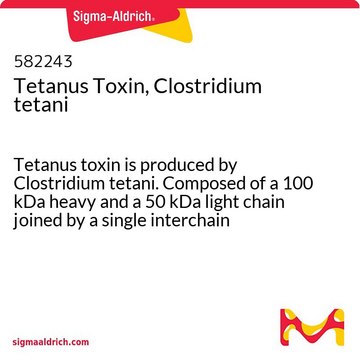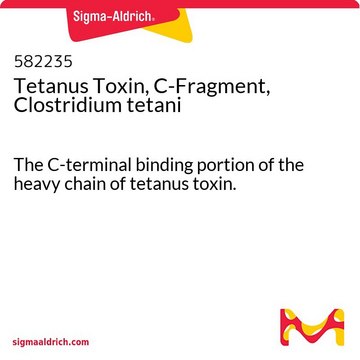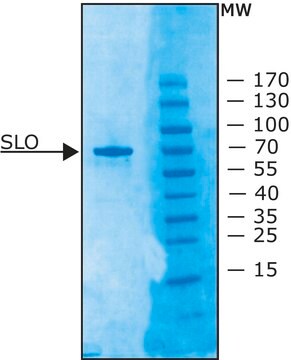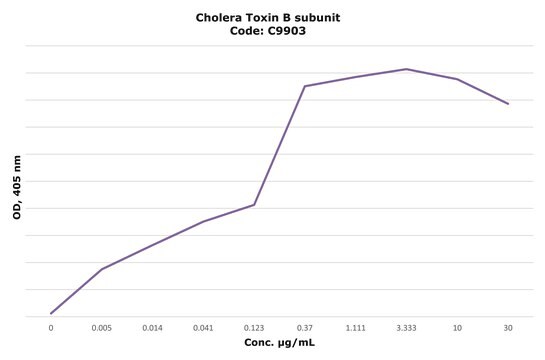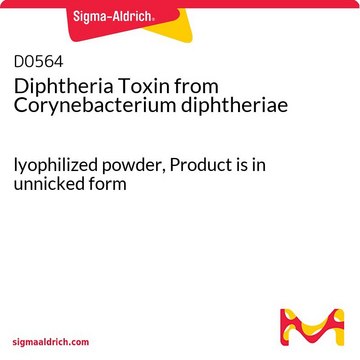T3694
Tetanus toxin C fragment from Clostridium tetani
Synonyme(s) :
TTC
Se connecterpour consulter vos tarifs contractuels et ceux de votre entreprise/organisme
About This Item
Produits recommandés
Poids mol.
apparent mol wt 47 kDa
Niveau de qualité
Couleur
white
Solubilité
H2O: soluble
Température de stockage
2-8°C
Description générale
Tetanus toxin C fragment (TTC) is a non-toxic peptide, which is transported from peripheral axons into spinal motoneurons. It provides protection for motoneurons (MN) in the spinal cord in vivo. TTC regulates membrane binding, internalization and retrograde transport within MN. It initiates neurotrophin-regulated signaling pathways in a Trk receptor-dependent manner. TTC has neuroprotective property in primary cerebellar granule cell culture.
Application
The C terminal binding portion of tetanus toxin is not toxic but is taken up by pre-synaptic nerve terminals and exhibits trans-synaptic retrograde transport in central neurons similar to that of tetanus toxin.
The C terminal binding portion of tetanus toxin is not toxic but is taken up by pre-synaptic nerve terminals and exhibits trans-synaptic retrograde transport in central neurons similar to that of tetanus toxin. It is used to map neuronal connections and to target proteins to neurons.
Actions biochimiques/physiologiques
Tetanus toxin is a neurotoxin that comprises of a heavy and a light chain linked by disulfide bridges. This neurotoxin enters the cytoplasm and releases the light chain component that subsequently inhibits the release of neurotransmitters2. Studies have reported that the fragment C of tetanus toxin retains most of the determinants that interact with thyroid membranes, gangliosides and neural membranes3.
Reconstitution
Each vial, when reconstituted with 50 μl of sterile distilled water, contains 10 μg of tetanus toxin C-fragment in 0.01 M sodium phosphate, pH 7.5. To aid recovery, 0.1% albumin may be added.
Mention d'avertissement
Danger
Mentions de danger
Conseils de prudence
Classification des risques
Acute Tox. 1 Oral - Acute Tox. 2 Inhalation - STOT SE 1
Organes cibles
Central nervous system
Code de la classe de stockage
6.1A - Combustible acute toxic Cat. 1 and 2 / very toxic hazardous materials
Classe de danger pour l'eau (WGK)
WGK 3
Point d'éclair (°F)
Not applicable
Point d'éclair (°C)
Not applicable
Faites votre choix parmi les versions les plus récentes :
Déjà en possession de ce produit ?
Retrouvez la documentation relative aux produits que vous avez récemment achetés dans la Bibliothèque de documents.
Les clients ont également consulté
T B Helting et al.
The Journal of biological chemistry, 252(1), 187-193 (1977-01-10)
Tetanus toxin was digested with papain, yielding one major polypeptide (Fragment C) with a molecular weight corresponding to 47,000 +/- 5%, thus comprising about one-third of the toxin molecule. Fragment C was antigenically active, atoxic, and stimulated the formation of
Tetanus toxin C-fragment protects against excitotoxic spinal motoneuron degeneration in vivo
Netzahualcoyotzi C and Tapia R
Scientific Reports, 8(1), 16584-16584 (2018)
Interaction of fragments B and C of tetanus toxin with neural and thyroid membranes and with gangliosides.
N P Morris et al.
The Journal of biological chemistry, 255(13), 6071-6076 (1980-07-10)
E Link et al.
Biochemical and biophysical research communications, 189(2), 1017-1023 (1992-12-15)
Tetanus toxin is a potent neurotoxin that inhibits the release of neurotransmitters from presynaptic nerve endings. The mature toxin is composed of a heavy and a light chain that are linked via a disulfide bridge. After entry of tetanus toxin
Notre équipe de scientifiques dispose d'une expérience dans tous les secteurs de la recherche, notamment en sciences de la vie, science des matériaux, synthèse chimique, chromatographie, analyse et dans de nombreux autres domaines..
Contacter notre Service technique


